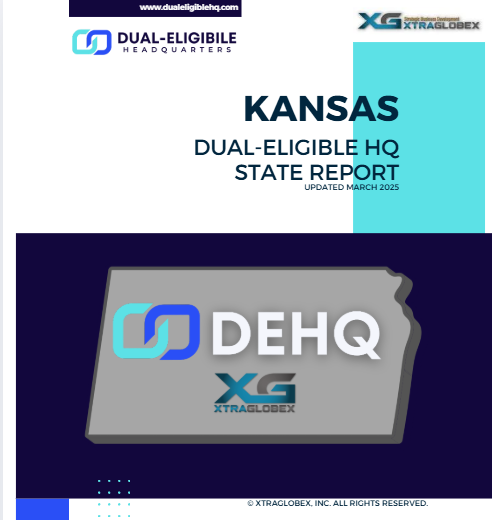Kansas DEHQ State Report
In Kansas, the state coordinates care for more than 40,000 full-benefit dual-eligibles through a variety of systems, including KanCare (Medicaid managed care), Dual-eligible Special Needs Plans (D-SNPs), and the Program of All-Inclusive Care for the Elderly (PACE). These programs aim to deliver medical care, behavioral health services, and long-term services and supports in an integrated and cost-effective way.
Dual-eligibility refers to someone who qualifies for both Medicare and Medicaid coverage. They are often individuals with limited income that are either age 65 or older or under 65 with a qualifying disability. You can find more on the basics of dual-eligibility here.
In our latest Kansas Dual-Eligible HQ State Report, published in April 2025, we explore how services are coordinated and delivered for dual-eligibles in Kansas. The report offers the most current information available on program structures, eligibility criteria, managed care requirements, and enrollment data for duals in Kansas. It’s designed as a resource for policymakers, researchers, and program administrators working to improve care for dual-eligible populations.
In the Kansas Dual-Eligible HQ State Report, you’ll find answers to key questions, including:
- How is Kansas’s Medicaid system structured, and what role do managed care organizations (MCOs) play?
- What services do dual-eligible individuals receive through KanCare and D-SNPs?
- Who qualifies as a dual-eligible in Kansas, and how do full vs. partial duals differ?
- How are long-term services and supports (LTSS), behavioral health, and home and community-based services delivered to dual-eligibles?
- What programs serve older adults and individuals with disabilities in Kansas, including PACE and HCBS waivers?
- Who oversees dual-eligible care in Kansas, and what state agencies are involved?
- What are the most recent dual-eligible enrollment figures in Kansas?
- How are value-based care and quality incentives used in KanCare MCO contracts?
- What trends are emerging in dual-eligible enrollment and care coordination across the state?
In the New York Dual-Eligible HQ State Report, you’ll find answers to questions like:
- How is New York Medicaid structured, and how do managed care options differ for dual-eligible individuals?
- What is the difference between D-SNPs, IB-Dual programs, HARP, MAP, and PACE in terms of care delivery and integration?
- Who qualifies as a dual-eligible in New York, and how are physical health, behavioral health, and LTSS coordinated?
- How are IDD services delivered to dual-eligible individuals?
- How does care coordination work across MMC plans, D-SNPs, MLTC plans, and integrated models?
- What are the latest enrollment figures for dual-eligible individuals in New York?
- How is New York using value-based payment models to improve outcomes and manage costs for dual-eligible populations?


